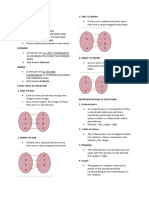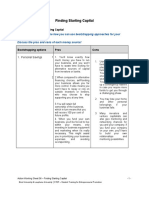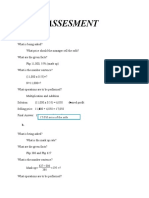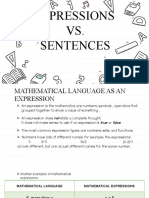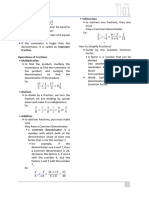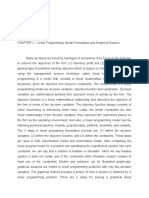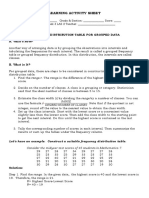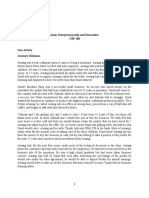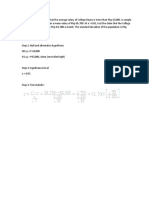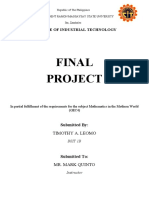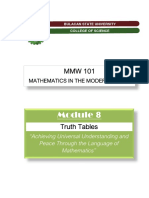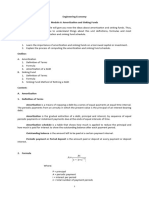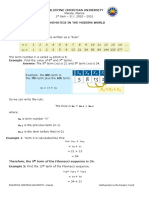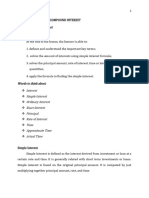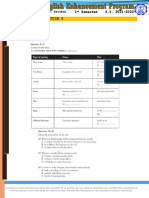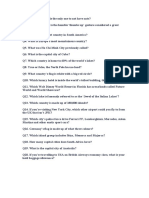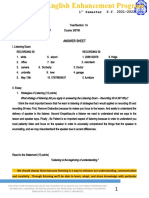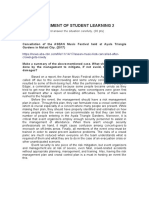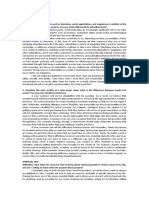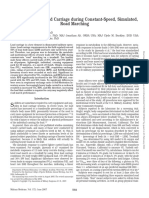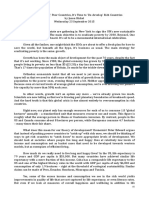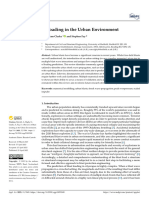Polya’s 4-Steps in Problem Solving
In 1945, George Polya published the book How to Solve it: A New Aspect of
Mathematical Method which later became widely accepted design of how students
should proceed with problem-solving processes. Although the book generally
revolves around mathematical problems, Polya emphasized that the same strategy
can be applied when students encounter real-life problems.
George Polya’s 4-steps in problem solving
• Understand the problem. This requires reading the problem slowly and recognizing the
information given in the problem. This is achieved when all the words used in stating the
problem is fully understood, it can be restated in one’s own words and what is being asked for
SEE is identified. One has to have a clear grasp of the problem at hand, especially the relationship
that exists between the given and the unknown quantities.
•Devise a plan. To devise a plan is to come up with a way to solve the problem.
There are many different types of plans for solving problems which include: setting
up an equation, drawing a diagram, making a chart, guess and check, look for a
PLAN pattern, make an orderly list, draw a picture, eliminate the possibilities, use a model,
work backwards.
•Carry out the plan. This step is where the identified plan is applied to solve the
problem. If a plan does not work, it can be modified or changed. Common sense and
DO natural thinking abilities can help this step.
•Look back. This step is where answers can be verified and checked and where
mistakes can be identified. Verify and check if the answer makes sense or correct
based on the situation posed in the problem. This is a time to review what you have
CHECK done, what worked and what didn’t.
Now let us try to solve mathematical problems involving finances using Polya’s 4-steps in
problem solving.
Problem 1. Seph invested a certain amount of money at 5% interest rate. The interest earned
in a year is Php15 000.00. How much money was invested?
Note: Step 1. See. To understand the problem, we have to identify the given and what is being
Simple interest refers to
an interest that is asked.
computed only once from
the time the amount is
borrowed or invested until
Given: a certain amount of money is invested at 5% interest rate
it is paid Php15 000.00 interest was earned in a year
Note: Find: amount of money invested
Use the decimal
equivalent of the given
percentage.
THIS MODULE IS FOR THE EXCLUSIVE USE OF THE UNIVERSITY OF LA SALETTE, INC. ANY FORM OF REPRODUCTION, DISTRIBUTION,
UPLOADING, OR POSTING ONLINE IN ANY FORM OR BY ANY MEANS WITHOUT THE WRITTEN PERMISSION OF THE UNIVERSITY IS
STRICTLY PROHIBITED.
1
� Step 2. Plan. Devise a plan by representing the given and by forming equations using the
information in step 1. Simple interest is determined by
multiplying the principal by
Represent the given: the interest rate by the time that
elapse between payments.
Let P = amount of money invested I = Prt
I = 15 000 Where:
Come up with an equation by substituting I = Simple interest
the values represented to the formula r = 5% or 0.05 P = amount invested/borrowed or
I = Prt t = 1 year principal
r = interest rate
t = time
If I = Prt, then 15 000 = P (0.05)(1)
Step 3. Do. Carry out the plan by solving the equation in step 2.
15 000 = P (0.05)(1)
15 000 0.05 𝑃 Simplify the right side of the equation.
= Then divide both sides by 0.05 to
0.05 0.05 isolate P.
Simplify to get the value of P.
P = 300 000
If P = 300 000, then the amount of money invested was Php300 000.00.
Step 4. Check. Look back and see if the values (answers) obtained are correct.
Again, using the formula I = Prt, we can verify if Php300 000.00 was the
amount invested from the lending company but this time we will substitute P
with 300 000.
I = (300,000) (0.05) (1)
I = 15 000
Since Php300, 000.00 earned an interest amounting to Php15 000.00, then we did
the problem correctly.
Problem 2. A certain amount of money was borrowed from a certain lending company
payable for 2 years at 8% simple interest. A Php6 000.00 was paid for the interest of
the loan. How much was the amount of money borrowed from the lending company?
Step 1. See. To understand the problem, we have to identify the given and what is being
asked.
Given: amount borrowed payable for 2 years at 8% simple interest
THIS MODULE IS FOR THE EXCLUSIVE USE OF THE UNIVERSITY OF LA SALETTE, INC. ANY FORM OF REPRODUCTION, DISTRIBUTION,
UPLOADING, OR POSTING ONLINE IN ANY FORM OR BY ANY MEANS WITHOUT THE WRITTEN PERMISSION OF THE UNIVERSITY IS
STRICTLY PROHIBITED.
2
� Php6 000.00 was paid for the interest of the loan
Find: amount of money borrowed.
Step 2. Plan. Devise a plan by representing the given and by forming an equation using
the information in step 1.
Represent the given: Use simple interest formula
Let P = principal or the amount borrowed
I = 6 000
r = 8% or 0.08
t = 2 years
If I = Prt, then 6 000 = P (0.08) (2)
Step 3. Do. Carry out the plan by solving the equation in step 2.
6 000 = P (0.08) (2) Simplify the right side of the equation.
6 000 0.16 𝑃 Then divide both sides by 0.16 to
= isolate P.
0.16 0.16 Simplify to get the value of P.
P = 37 500
If P = 37 500, then the amount of money borrowed was Php37 500.00.
Step 4. Check. Look back and see if the values (answers) obtained are correct.
Again, using the formula I = Prt, we can verify if Php37 500.00 was the amount
borrowed from the lending company but this time we will substitute P with 37,
500.
I = (37,500) (0.08) (2)
I = 6 000
Since Php37 500.00 gained a simple interest amounting to Php6 000.00, then we
did the problem correctly.
Problem 3. A Php12 000.00 was borrowed from a rural bank which is payable within 3 years
with 12% simple interest. How much will be repaid after three years?
THIS MODULE IS FOR THE EXCLUSIVE USE OF THE UNIVERSITY OF LA SALETTE, INC. ANY FORM OF REPRODUCTION, DISTRIBUTION,
UPLOADING, OR POSTING ONLINE IN ANY FORM OR BY ANY MEANS WITHOUT THE WRITTEN PERMISSION OF THE UNIVERSITY IS
STRICTLY PROHIBITED.
3
�Note:
Maturity Value is the
sum of the principal
Step 1. See. To understand the problem, we have to identify the given and what is being
amount and the asked.
interest.
𝐹 =𝑃+𝐼 Given: amount borrowed was Php12, 000.00
Where:
payable within 3 years at 12% simple interest
F = maturity value
P = principal
I = interest Find: amount of money to be repaid after three years or the maturity
value
Using simple interest
formula I = Prt,
maturity value can be
Step 2. Plan. Devise a plan by representing the given and by forming an equation using
computed as the information in step 1.
𝐹 = 𝑃 + 𝑃𝑟𝑡
By factoring Represent the given:
𝑭 = 𝑷(𝟏 + 𝒓𝒕) Let F = maturity value
P = 12 000
r = 12% or 0.12 Come up with an equation by substituting
the values represented to the formula
t = 3 years 𝐹 = 𝑃(1 + 𝑟𝑡)
Therefore, F = 12 000[1 + (0.12) (3)]
Step 3. Do. Carry out the plan by solving the equation in step 2.
F = 12 000[1 + (0.12) (3)]
F = 12 000(1.36)
F= 16 320
If F = 16 320, then the total amount of money to be repaid is Php16 320.00.
Step 4. Check. Look back and see if the values (answers) obtained are correct.
By adding the principal and the interest we can verify if the computed maturity value
is 16, 320.
I = (12000) (0.12) (3)
I = 4 320
F = 12 000 + 4 320
F = 16 320
Since the amount computed in step 3 and step 4 are the same, then we did the problem
correctly.
THIS MODULE IS FOR THE EXCLUSIVE USE OF THE UNIVERSITY OF LA SALETTE, INC. ANY FORM OF REPRODUCTION, DISTRIBUTION,
UPLOADING, OR POSTING ONLINE IN ANY FORM OR BY ANY MEANS WITHOUT THE WRITTEN PERMISSION OF THE UNIVERSITY IS
STRICTLY PROHIBITED.
4
� Problem 4. An employee applied for a salary loan amounting to Php15, 000.00 from their
association payable in 12 months with a monthly interest of 1.5%. How much will be
deducted from his salary every month?
Step 1. See. To understand the problem, we have to identify the given and what is being
asked.
Given: Php15, 000.00 amount of salary loan
Payable in 12months
1.5% monthly interest
Find: monthly salary deduction.
Step 2. Plan. Devise a plan by representing the given and by forming an equation using
the information in step 1.
Represent the given:
Let F = maturity value Use maturity value formula
I = interest
P = 15 000
r = 1.5% or 0.015
t = 12 months
If F = P (1 + rt), then F = 15 000[1 + (0.015) (12)]
Come up with an equation to solve
for the monthly deduction 𝑭
Monthly salary deduction =
𝟏𝟐
Step 3. Do. Carry out the plan by solving the equations in step 2.
Simplify by performing operations
F = 15 000[1 + (0.015) (12)] inside the grouping symbols first.
F = 15 000(1.18)
F= 17 700
If F = 17 700, then the total amount of money to be repaid is Php17 700.00.
𝑭 Now that the maturity value (F) is already
Monthly deduction = known, we can now solve for the monthly
𝟏𝟐
salary deduction.
17 700
=
12
= 1 475
The employees’ monthly salary deduction will be Php1, 475.00.
Step 4. Check. Look back and see if the values (answers) obtained are correct.
THIS MODULE IS FOR THE EXCLUSIVE USE OF THE UNIVERSITY OF LA SALETTE, INC. ANY FORM OF REPRODUCTION, DISTRIBUTION,
UPLOADING, OR POSTING ONLINE IN ANY FORM OR BY ANY MEANS WITHOUT THE WRITTEN PERMISSION OF THE UNIVERSITY IS
STRICTLY PROHIBITED.
5
� Using I = Prt, we can verify if the monthly salary deduction is Php1 475.00
I = 15 000 (0.015) (12) = 2 700
15,000+2,700
Monthly salary deduction = = 1,475
12
Since we still got the same value using different methods, then we did the problem
right.
Recreational Problems Involving Mathematics
Most people don’t do mathematics for recreation. You can go your whole life thinking of
“mathematics” as calculations, a bit of algebra, and maybe the quadratic formula. (Oldridge, 2019).
But have you ever heard of Recreational Mathematics?
Recreational mathematics
A mathematics carried out for recreation (entertainment) and is intended to be fun rather
than as a strictly research and application-based professional activity or as a part of a
student's formal education. Many topics in this field require no knowledge of advanced
mathematics.
It involves mathematical puzzles and games, often appealing to children and untrained
adults, inspiring their further study of the subject.
It can be surprisingly popular, with millions of people at one time or another having
enjoyed Rubik's Cube, Sudoku, Sungka or Philippine Mancala, logic problems, and
many other diversions.
Examples of Recreational Mathematics
1. The Magic Square – an arrangement of numbers in a square such that all rows, all
columns, and both main diagonals sum to the same number, a number referred to as
the magic constant.
4
3 Given a 3x3 square, place the numbers 1 to 9 so that each row, column and diagonal
8 6 adds up to the same number. Use each number exactly once. (Bold faced numbers
are the 9given)
6. Since is the only number not in the
box, then the last cell would be 9
5. To fill this cell you may use any of the
available info. Let’s try to use 15 – (7+6) = 2
1. In the given square, the sum of the numbers in
4 9 2
first column is 15, hence, we can say that 15 is 3 5 7 4. You can now fill the middle
the Magic constant. 8 1 6 row. 15 – (3+5) = 7
3. Another cell you can
easily fill in is this
2. Look for a cell which you can easily fill next. In this case,
diagonal (you may also
the bottom row. 15 – (8+6) = 1
do this diagonal first
before the bottom row)
15 – (4+6) = 5
THIS MODULE IS FOR THE EXCLUSIVE USE OF THE UNIVERSITY OF LA SALETTE, INC. ANY FORM OF REPRODUCTION, DISTRIBUTION,
UPLOADING, OR POSTING ONLINE IN ANY FORM OR BY ANY MEANS WITHOUT THE WRITTEN PERMISSION OF THE UNIVERSITY IS
STRICTLY PROHIBITED.
6
� 2. Sungka or Philippine Mancala –a two-player turn-based Filipino local game wherein
the players compete to obtain more stones than the other. The game unleashes the
competitiveness of a person. Somehow, the Sungka game seems to be a mind game. It is
also known to improve the mathematical thinking and observation skills of an individual.
The game is played on a solid wooden block with two rows of seven circular holes and
two large holes at both ends called "head". It begins with 49 game pieces (shells, marbles,
pebbles or seeds) equally distributed to alternate holes - seven pieces in every other hole
- except "heads" which remain empty. Each player controls the seven holes on his side
of the board and owns the "head" to his right. The goal is to accumulate as many pieces
in your own "head".
https://kapampangan.org/sungka/
You may want to play the game for a break from this module.
THIS MODULE IS FOR THE EXCLUSIVE USE OF THE UNIVERSITY OF LA SALETTE, INC. ANY FORM OF REPRODUCTION, DISTRIBUTION,
UPLOADING, OR POSTING ONLINE IN ANY FORM OR BY ANY MEANS WITHOUT THE WRITTEN PERMISSION OF THE UNIVERSITY IS
STRICTLY PROHIBITED.
7
� REFERENCES
Romeo M. Daligdig, EdD (2019). Mathematics in the Modern World. Problem Solving and
Reasoning. Lorimar Publishing,Inc. 40 – 49
Earnhart, R T., and Adina E M. (2018). Mathematics in the Modern World. Problem Solving and
Reasoning. C & E Publishing,Inc. 78 – 88
Aduana, Nick L. (2012). Mathematics of Investment. Quezon City: C&E Publishing,Inc.
Matthew Oldridge (July 16, 2019). Martin Gardner and Recreational Mathematics. Retrieved from
https://medium.com/@MatthewOldridge/recreational-mathematics-d72dfbd68226
James Yolkowski (January 12, 2015) Recreational Mathematics. Retrieved from
https://mathlair.allfunandgames.ca/recreational.php
(nd) Retrieved from. https://kami.com.ph/112571-how-to-play-sungka.html
https://www.hostos.cuny.edu/Hostos/media/Office-of-the-President/Institutional-Research-
Assessment/Problem-Solving-Rubric.pdf
THIS MODULE IS FOR THE EXCLUSIVE USE OF THE UNIVERSITY OF LA SALETTE, INC. ANY FORM OF REPRODUCTION, DISTRIBUTION,
UPLOADING, OR POSTING ONLINE IN ANY FORM OR BY ANY MEANS WITHOUT THE WRITTEN PERMISSION OF THE UNIVERSITY IS
STRICTLY PROHIBITED.
8


